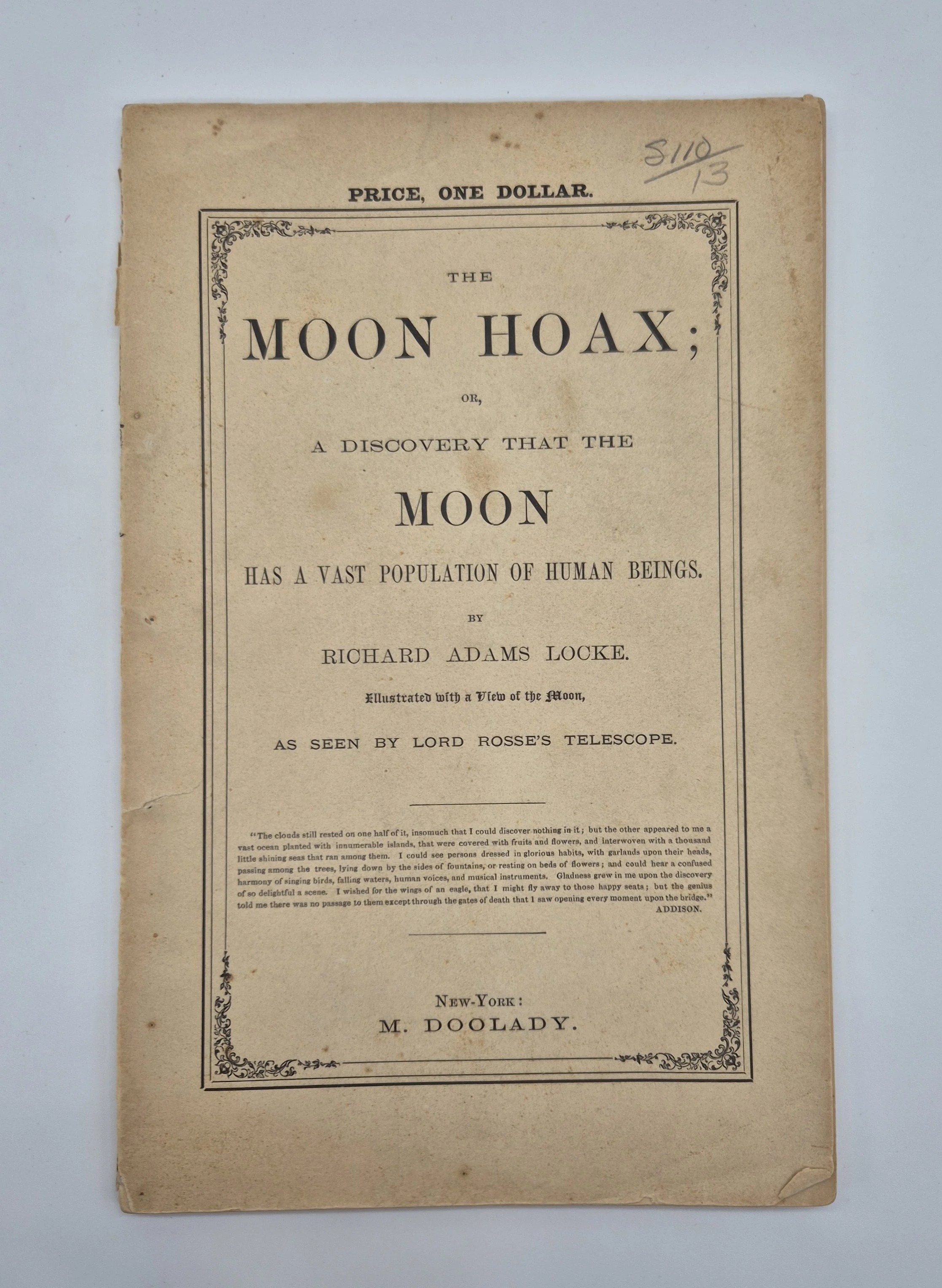 Image 1 of 2
Image 1 of 2

 Image 2 of 2
Image 2 of 2



The Moon Hoax; a Discovery that the Moon has a Vast Population of Human Beings… Illustrated with a View of the Moon, as Seen by Lord Rosse’s Telescope
LOCKE, Richard Adams
The Moon Hoax; a Discovery that the Moon has a Vast Population of Human Beings… Illustrated with a View of the Moon, as Seen by Lord Rosse’s Telescope
New York: William Gowans, 1859
8vo., original wrappers, printed with text and decorative borders in black to upper cover, priced ‘One Dollar’ to the upper edge; title sometime handwritten in black to spine; pp. [v], vi, [i], 8-63 + [iii, additional title], [v], 4-12, ads, [iv, blanks]; with large frontis illustrating the moon; covers with a couple of light brown spots and pencil markings; spine split, front cover now detached; one short horizontal tear and lightly creased/chipped to upper cover; neat pencil ownership mark to inside rear cover; else an exceptionally clean and bright example, seldom found thus, which may perhaps benefit from a box or rebind.
A later, though still surprisingly scarce edition of Locke’s successful hoax which was originally published in the New York Sun in August 1835. The story, which made front page news, was based on a claim that a famous English astronomer, with a wonderful new telescope mounted in South Africa, had discovered life on the lunar surface. As the story continued to run over the following days, even more outlandish claims surfaced; that the telescope, a massive 24 feet in diameter, and which could amplify objects up to 42,000 times, had shown the existence of unicorns, beaver-like creatures and, most astoundingly, humans with bat wings flying about the moon. With the revelations seemingly reprinted from the (actually defunct) Edinburgh Journal of Science, many members of the public believed the claims, and several lithographs followed showing these fantastical creatures in all of their finery. Though it is hard to believe now, the report was even given credence in a series of scientific journals throughout the US and Europe before it was finally admitted to be a hoax, though by that time circulation of the previously fledgling newspaper soared to more than nineteen thousand, the largest of any daily at the time.
An early printing of this popular hoax, seldom found in such bright condition.
LOCKE, Richard Adams
The Moon Hoax; a Discovery that the Moon has a Vast Population of Human Beings… Illustrated with a View of the Moon, as Seen by Lord Rosse’s Telescope
New York: William Gowans, 1859
8vo., original wrappers, printed with text and decorative borders in black to upper cover, priced ‘One Dollar’ to the upper edge; title sometime handwritten in black to spine; pp. [v], vi, [i], 8-63 + [iii, additional title], [v], 4-12, ads, [iv, blanks]; with large frontis illustrating the moon; covers with a couple of light brown spots and pencil markings; spine split, front cover now detached; one short horizontal tear and lightly creased/chipped to upper cover; neat pencil ownership mark to inside rear cover; else an exceptionally clean and bright example, seldom found thus, which may perhaps benefit from a box or rebind.
A later, though still surprisingly scarce edition of Locke’s successful hoax which was originally published in the New York Sun in August 1835. The story, which made front page news, was based on a claim that a famous English astronomer, with a wonderful new telescope mounted in South Africa, had discovered life on the lunar surface. As the story continued to run over the following days, even more outlandish claims surfaced; that the telescope, a massive 24 feet in diameter, and which could amplify objects up to 42,000 times, had shown the existence of unicorns, beaver-like creatures and, most astoundingly, humans with bat wings flying about the moon. With the revelations seemingly reprinted from the (actually defunct) Edinburgh Journal of Science, many members of the public believed the claims, and several lithographs followed showing these fantastical creatures in all of their finery. Though it is hard to believe now, the report was even given credence in a series of scientific journals throughout the US and Europe before it was finally admitted to be a hoax, though by that time circulation of the previously fledgling newspaper soared to more than nineteen thousand, the largest of any daily at the time.
An early printing of this popular hoax, seldom found in such bright condition.

